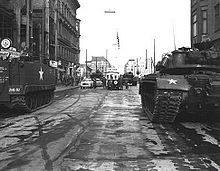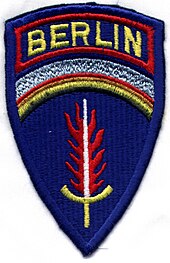Berlin Brigade
Berlin Brigade was the name of the brigades of the United States Army and the British Army that were stationed in Berlin under the Yalta and Potsdam agreements .
As a result of the agreements of the Four Powers , Greater Berlin was divided into four sectors after the unconditional surrender of the Wehrmacht in 1945 . The Soviet Union , the United Kingdom , France, and the United States stationed troops in their sectors. Members of the occupying powers were able to move around the entire city on foot or in vehicles without being checked when crossing a sector boundary.
The name Berlin Brigade was only used for the US units in Berlin. The official name of the British units was Berlin Infantry Brigade . France maintained its garrison in Berlin under the name Forces Françaises à Berlin .
The Soviet Union withdrew from the Allied Control Council in 1948 . With the Soviet blockade of Berlin in 1948/49, the Allied troops were put to the first test. During the Cold War , the Western Allied units had the task of protecting Berlin against Soviet and East German troops . The Federal Republic of Germany was not allowed to station units of the Bundeswehr in Berlin.
After the end of the Cold War, the Allied troops withdrew from Berlin by July 1994 in accordance with the provisions of the Two-Plus-Four Treaty .
units
US Army
The Berlin Brigade of the US Armed Forces was part of US Army Europe . The soldiers wore the US Army shoulder badge.
The regular stationing of US troops in Berlin began on July 4, 1945 with the 2nd US Armored Division . In the same year this was replaced by the 82nd US Airborne Division and the 78th US Infantry Division . Until 1949, the US troops in Berlin were called Berlin Military Post , then the name Berlin Command and the US Army Garrison was chosen.
In 1950 the 6th US Infantry Regiment with three battalions was stationed in Berlin. In 1958 the regiment was reinforced by another tank company so that combat groups could be formed.

When, after the construction of the Berlin Wall on August 13, 1961, Vice President Lyndon B. Johnson visited Berlin on August 20, 1961, a reinforcement of 1,500 men from the 8th Army moved overland across the territory of the GDR - celebrated by the West Berliners . US infantry division in Berlin.
At the end of October 1961, a serious incident occurred when GDR border guards at the Friedrichstrasse border crossing asked members of the US armed forces in uniform and civilian clothes to undergo a border control before entering East Berlin . This represented a clear violation of allied agreements. As a result, US M48 A1 battle tanks , M59 APC armored personnel carriers and Soviet T-54s were ready to fight against each other at Checkpoint Charlie . The dangerous situation was defused shortly afterwards with Soviet participation. The uniformed members of the occupying powers were still allowed to cross the sector border in an uncontrolled manner. Civilians were now required to carry an identity card, which they had to show on request.
On December 1, 1961, the US troops in Berlin were restructured. The Berlin Command became the US Army Berlin Brigade . In 1962 an additional artillery battery (Battery C, 94th Artillery) was relocated to Berlin.
From October 1971 a new restructuring took place: The previously independent tank company (Company F, 40th Armored Regiment) was subordinated to the 3rd Battalion, 6th Infantry Regiment and thus became a battalion combat group. A second combat group was formed from the 2nd Battalion, 6th Infantry Regiment and the C / 94th Artillery , a third from the 4th Battalion, 6th Infantry Regiment and the 42nd Engineer Company .
In June 1984 the infantry units were renamed, resulting in battalions 4, 5 and 6 of the 502nd Infantry Regiment. In 1986 the C / 94th Artillery was renamed the E / 320th Artillery . In 1990 the tank company was reclassified into a battalion (6th Battalion, 40th Armor) and equipped with the modern M1 Abrams main battle tank .
With the reunification of Germany , the situation of the US Army Berlin Brigade changed fundamentally, as the main threat posed by Soviet troops no longer existed. In 1991 the 4th Battalion, 502nd Infantry therefore left Berlin.
Parts of the Berlin Brigade were relocated to Macedonia in March 1993 as part of UNPROFOR . They also participated in Operation Able Sentry .
The Berlin Brigade was officially deactivated on July 6, 1994 by US President Bill Clinton .
The following units were recently stationed in Berlin:
- Headquarters , US Army Berlin Brigade (BBDE)
- 4th Battalion, 502nd Infantry Regiment
- 5th Battalion, 502nd Infantry Regiment
- 6th Battalion, 502nd Infantry Regiment
- Battery E, 320th Field Artillery
- 6th Battalion, 40th Armored Regiment
- 42nd Engineer Company
- 42nd Military Police Group
- 287th Military Police Company
- 43rd Chemical Detachment
- 766th Military Intelligence Detachment
- 168th Medical Detachment
- 298th Army Band
- 7782nd Special Troops Battalion
- 7350th US Air Base Group
- 8001st US Army Reserve
- Berlin Aviation Detachment
- 6941st Guard Battalion
A weekly troop magazine, the Berlin Observer , was published between 1945 and 1994 for the troops of the Berlin Brigade and their relatives .
British Army

The Berlin Infantry Brigade of the British Army comprised three infantry battalions, a tank squadron and other support units with a total of 3,000 soldiers. The brigade was initially not part of the British Army of the Rhine (BAOR). It was not assigned to the BAOR until the mid-1980s.
The brigade's infantry battalions were rotated every two years. The Panzer Squadron was assigned to the 1st Corps of the Rhine Army. The following were permanently stationed in Berlin:
- 7th Flight Army Air Corps
- 62 Transport and Movements Squadron RCT
- 38 (Berlin) Field Squadron RE
- 229 Signals Squadron R Signals
- 247 Provost Company - RMP
- 248 German Security Unit - RMP
- British Military Hospital Berlin
- 3 Intelligence & Security Company
| date | Surname |
|---|---|
| November 1946 | British Troops Berlin |
| February 1949 | Area Troops Berlin |
| October 1953 | Berlin Infantry Brigade Group |
| December 1963 | Berlin Infantry Brigade |
| April 1977 | Berlin Field Force |
| January 1981 | Berlin Infantry Brigade |
See also
literature
- William Durie: The British Garrison Berlin 1945–1994. A Pictorial Historiography of the British Occupation . Past Publishing, Berlin 2012, ISBN 978-3-86408-068-5 . (English)
Web links
- History of the French, American and British Berlin Brigades. Retrieved March 28, 2009 .
- Hans-Joachim Strangmann: Maps of US installations in Berlin. Retrieved March 28, 2009 .
- West Allied Museum in Berlin. Retrieved December 15, 2010 .
- Website of the eyewitness project GSU History Accessed December 28, 2019 (German)
Individual evidence
- ^ Horst Ulrich, Uwe Prell, Ernst Luuk: Berlin Handbook. The lexicon of the federal capital. FAB-Verlag, Berlin 1992, ISBN 3-927551-27-9 , p. 257 f.
- ^ Graham Watson, Richard A. Rinaldi: The British Army in Germany (BAOR and after): An Organizational History 1947-2004 . Tiger Lily Publications LLC, 2005, ISBN 0-9720296-9-9 (Retrieved December 15, 2010). , P. 127



